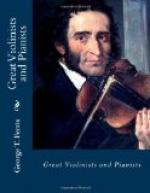At Ancona, Tartini attained such reputation as a player and musician that he was appointed, in 1721, to the directorship of the orchestra of the church of St. Anthony at Padua. Here, according to Fetis, he spent the remaining forty-nine years of his life in peace and comfort, solely occupied with the labors connected with the art he loved.
His great fame brought him repeated offers from the principal cities of Europe, even London and Paris, hat nothing could induce him to leave his beloved Italy. Though Tartini could not have been heard out of Italy, his violin school at Padua graduated many excellent players, who were widely known throughout the musical world. Tartini’s compositions reached no less than one hundred and fifty works, distinguished not only by beauty of melody and knowledge of the violin, but by soundness of musical science. Some of his sonatas are still favorites in the concert-room. Among these, the most celebrated is the “Trille del Dia-volo,” or “Devil’s Sonata,” composed under the following circumstances, as related by Tartini himself to his pupil Lalande:
“One night in 1713,” he says, “I dreamed that I had made a compact with the devil, who promised to be at my service on all occasions. Everything succeeded according to my mind; my wishes were anticipated and desires always surpassed by the assistance of my new servant. At last I thought I would offer my violin to the devil, in order to discover what kind of a musician he was, when, to my great astonishment, I heard him play a solo, so singularly beautiful and with such superior taste and precision, that it surpassed all the music I had ever heard or conceived in the whole course of my life. I was so overcome with surprise and delight that I lost my power of breathing, and the violence of this sensation awoke me. Instantly I seized my violin in the hopes of remembering some portion of what I had just heard, but in vain! The work which this dream suggested, and which I wrote at the time, is doubtless the best of all my compositions, and I still call it the ’Sonata del Diavolo’; but it sinks so much into insignificance compared with what I heard, that I would have broken my instrument and abandoned music altogether, had I possessed any other means of subsistence.”




